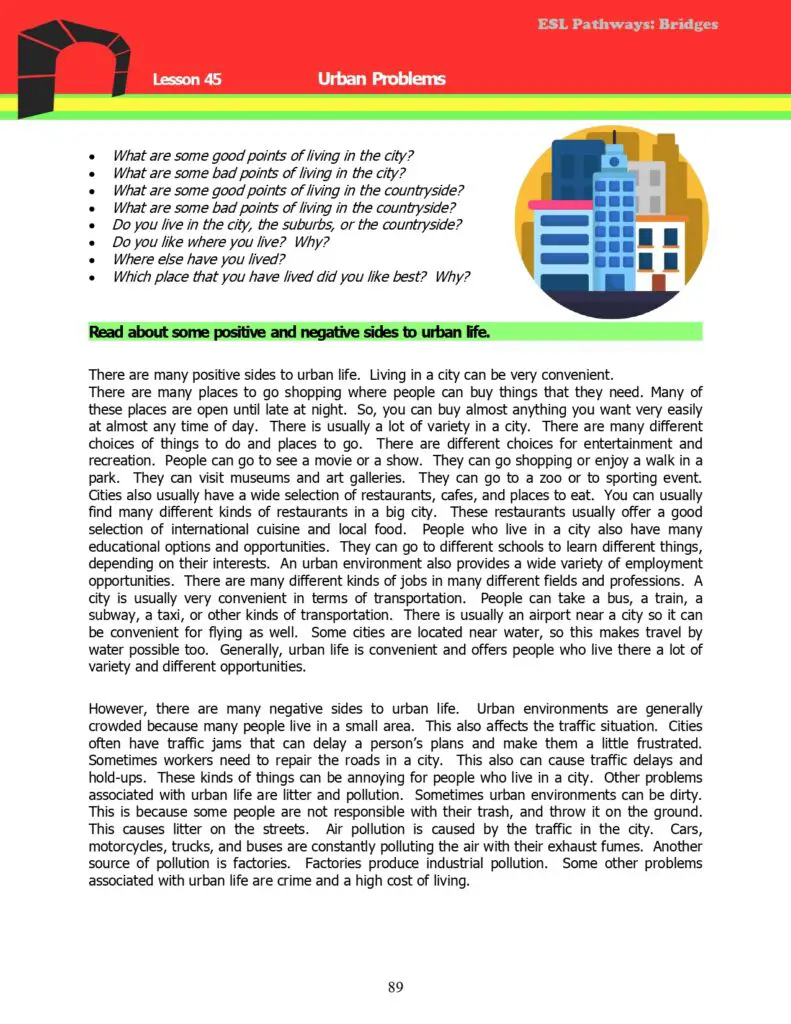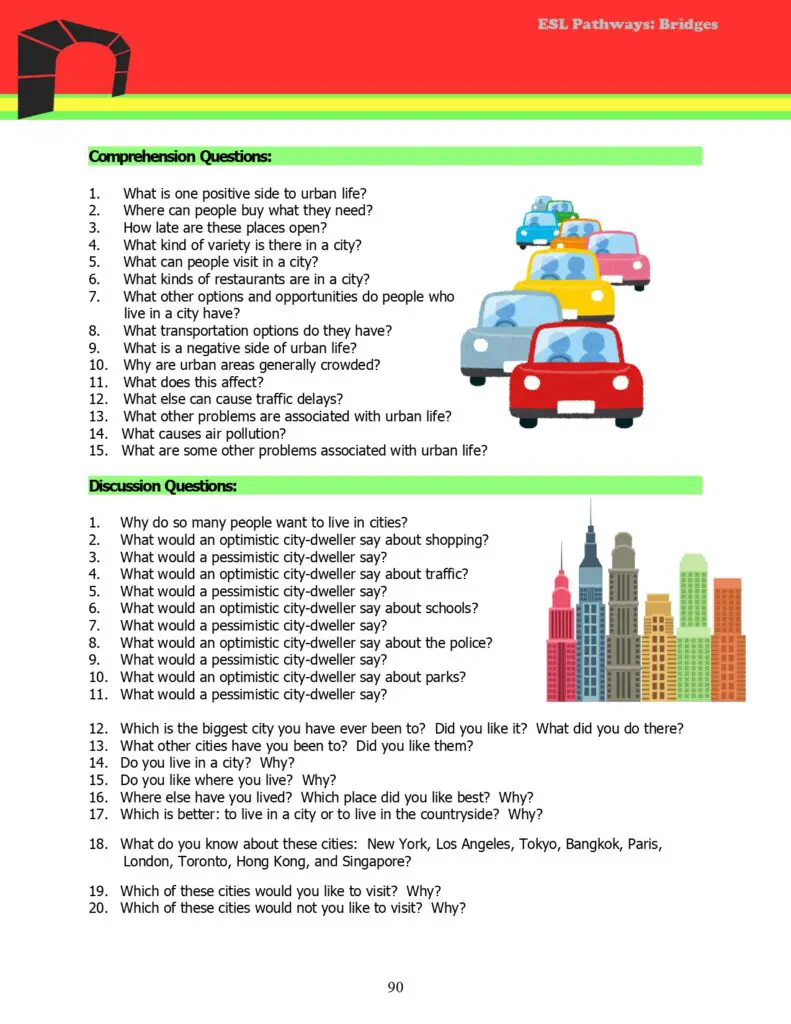This is Lesson 45, “Urban Problems,” from our collection of intermediate-level adult ESL lessons. The lesson features a reading passage about positive and negative aspects of urban life, followed by comprehension questions and discussion questions. This content-packed lesson is written with relatively simple English to help students transition to a more advanced level of English understanding and fluency. This lesson is available for free download, and you can download many other adult ESL lessons like this one in our book ESL Pathways: Bridges.


ADULT ESL LESSONS: Urban Problems (Text-Only Version)
- What are some good points of living in the city?
- What are some bad points of living in the city?
- What are some good points of living in the countryside?
- What are some bad points of living in the countryside?
- Do you live in the city, the suburbs, or the countryside?
- Do you like where you live? Why?
- Where else have you lived?
- Which place that you have lived did you like best? Why?
Read about some positive and negative sides to urban life.
There are many positive sides to urban life. Living in a city can be very convenient.
There are many places to go shopping where people can buy things that they need. Many of these places are open until late at night. So, you can buy almost anything you want very easily at almost any time of day. There is usually a lot of variety in a city. There are many different choices of things to do and places to go. There are different choices for entertainment and recreation. People can go to see a movie or a show. They can go shopping or enjoy a walk in a park. They can visit museums and art galleries. They can go to a zoo or to sporting event. Cities also usually have a wide selection of restaurants, cafes, and places to eat. You can usually find many different kinds of restaurants in a big city. These restaurants usually offer a good selection of international cuisine and local food. People who live in a city also have many educational options and opportunities. They can go to different schools to learn different things, depending on their interests. An urban environment also provides a wide variety of employment opportunities. There are many different kinds of jobs in many different fields and professions. A city is usually very convenient in terms of transportation. People can take a bus, a train, a subway, a taxi, or other kinds of transportation. There is usually an airport near a city so it can be convenient for flying as well. Some cities are located near water, so this makes travel by water possible too. Generally, urban life is convenient and offers people who live there a lot of variety and different opportunities.
However, there are many negative sides to urban life. Urban environments are generally crowded because many people live in a small area. This also affects the traffic situation. Cities often have traffic jams that can delay a person’s plans and make them a little frustrated. Sometimes workers need to repair the roads in a city. This also can cause traffic delays and hold-ups. These kinds of things can be annoying for people who live in a city. Other problems associated with urban life are litter and pollution. Sometimes urban environments can be dirty. This is because some people are not responsible with their trash, and throw it on the ground. This causes litter on the streets. Air pollution is caused by the traffic in the city. Cars, motorcycles, trucks, and buses are constantly polluting the air with their exhaust fumes. Another source of pollution is factories. Factories produce industrial pollution. Some other problems associated with urban life are crime and a high cost of living.
Comprehension Questions:
- What is one positive side to urban life?
- Where can people buy what they need?
- How late are these places open?
- What kind of variety is there in a city?
- What can people visit in a city?
- What kinds of restaurants are in a city?
- What other options and opportunities do people who
live in a city have?
- What transportation options do they have?
- What is a negative side of urban life?
- Why are urban areas generally crowded?
- What does this affect?
- What else can cause traffic delays?
- What other problems are associated with urban life?
- What causes air pollution?
- What are some other problems associated with urban life?
Discussion Questions:
- Why do so many people want to live in cities?
- What would an optimistic city-dweller say about shopping?
- What would a pessimistic city-dweller say?
- What would an optimistic city-dweller say about traffic?
- What would a pessimistic city-dweller say?
- What would an optimistic city-dweller say about schools?
- What would a pessimistic city-dweller say?
- What would an optimistic city-dweller say about the police?
- What would a pessimistic city-dweller say?
- What would an optimistic city-dweller say about parks?
- What would a pessimistic city-dweller say?
- Which is the biggest city you have ever been to? Did you like it? What did you do there?
- What other cities have you been to? Did you like them?
- Do you live in a city? Why?
- Do you like where you live? Why?
- Where else have you lived? Which place did you like best? Why?
- Which is better: to live in a city or to live in the countryside? Why?
- What do you know about these cities: New York, Los Angeles, Tokyo, Bangkok, Paris, London, Toronto, Hong Kong, and Singapore?
- Which of these cities would you like to visit? Why?
- Which of these cities would not you like to visit? Why?
